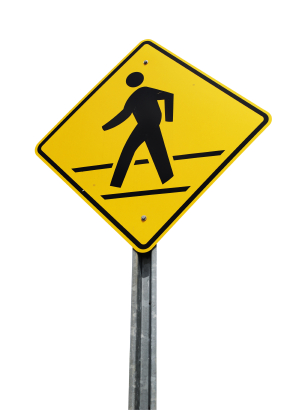In this next short part, we want to reiterate the importance of pedestrians' rights and responsibilities. We often think of pedestrians as only people who are on foot. But a pedestrian, according to CVC 467, is a person on foot, or who is using a means of transportation, other than a bicycle, that is propelled by human power (examples would be skateboards or in-line skates or non-motor scooters). The definition also includes any disabled person operating a self-propelled wheelchair, motorized tricycle or motorized quadricycle.

With this definition in mind, it is important for people in the above categories to realize that, even if they're on wheels, they fit the category of pedestrian if they're using the above devices. This goes for you, too, when you're not driving. Not only is it helpful for you, as a driver, to know what the law requires of pedestrians, but it is helpful for you as a pedestrian. Knowing these laws will help you to be a better pedestrian and more considerate of drivers when you're not behind the wheel.
According to the DMV, one in six traffic fatalities involves a pedestrian. Both pedestrians and drivers have responsibilities they must meet when interacting in close proximity. Below, we review rules for crosswalks, where pedestrians have the right of way. Please keep an eye out for them and stay out of their designated areas. Don't drive on the sidewalk, except to get to a driveway or alley.
The primary responsibility of a pedestrian is to cross at intersections and designated crosswalks. Sometimes, however, a crosswalk is not available. When there are no crosswalks, vehicles have the right of way. However, they should still be aware of pedestrians and, obviously, give them the right of way if they begin to cross the road! With this in mind, the pedestrian is responsible for using crosswalks or crossing only when it is safe to do so. There are certain areas where it is illegal for pedestrians to cross, according to the Vehicle Code: Pedestrians may not cross between two intersections controlled by traffic lights or police officers. They can be cited for "jaywalking."
Where there are no sidewalks outside of a business or residential district, pedestrians should walk close to the left hand side of the road, facing traffic. This makes them more visible to cars. As you can see, the rules regarding pedestrians are the result of the common-sense need to balance the highest priority of maintaining human life and limb, with the lesser - but still important - priority of helping traffic move efficiently. You are also allowed to walk close to the right hand side of the road if no crosswalks exists and crossing would be unsafe.
Blind Pedestrians
You must be prepared to interact with blind pedestrians when they cross the crosswalk or street. They must be given the right of way at all times. Here are some tips:
· The white cane is the signal to tell you that a person is blind. CVC 21964 prohibits anyone who is not blind from using these canes.
· Don't stop your car more than five feet from the crosswalk. The blind pedestrian might be depending on the sound of your car's motor to figure out where the crosswalk is, in relation to the vehicles. It helps to stop in the right place - with your bumper just a few inches from the edge of the crosswalk.
· Don't give verbal directions to the pedestrian. They were doing fine a few minutes ago when they were walking and you were driving. Again, blind pedestrians use traffic sounds as a guide, so voices are an unnecessary addition to the mix.
· Don't wait too long for the blind person to begin crossing the street. If he or she is standing on the sidewalk, takes a step back and pulls in the white cane, that's a definite sign the driver should go.
· Don't turn right on red without looking forward first. This not only helps with blind pedestrians, but also those who might not be paying attention to cars because they assume they are clear to go.
· Don't honk at a blind person; it just causes confusion and startles someone unnecessarily. Do we have to ask you how you'd feel?
Begin Test